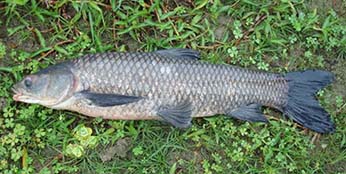(Mylopharyngodon piceus)
General Description
 Black carp. Photo by ABM Mohsin, University of Rajshahi.
Black carp. Photo by ABM Mohsin, University of Rajshahi.
Black carp are large, freshwater fish belonging to the minnow family. Their bodies are cylindrical, elongated, and slightly compressed. Adult black carp are black, blue-gray, or dark brown on their back and sides, with grayish white to cream colored bellies. Black carp have large scales outlined in black and very dark (almost black) fins. They have large, smooth pharyngeal (located in the throat) teeth that are used to crush the shells of mollusks (snails, mussels, and clams), which are their primary food source. Black carp can grow over 5 feet long and weigh up to 150 pounds. Black carp closely resemble grass carp, but can be distinguished by their darker coloration and smooth pharyngeal teeth.
Current Distribution
Black carp are not currently found, nor have they ever been reported, in California. They were first introduced into the United States in the 1970s. Black carp have been present in the lower Mississippi River Basin in and around the Red River (Louisiana) since the early 1990s. Both sterile and non-sterile forms of black carp are currently being utilized in several southern states in closed-water research and fish production facilities. Black carp are native to the major Pacific Ocean drainages of eastern Asia from China to far eastern Russia and possibly Vietnam. They have been introduced to many areas around the world, including Canada, Mexico, Central America, Africa, Europe, and throughout Asia outside of their natural range.
Habitat Preference
Black carp are bottom dwellers and prefer channels and associated floodplain lakes and backwaters of lowland rivers. They can also be found in lakes, reservoirs, and canals, although they require riverine environments with long reaches, high water volume, turbulent flow, and warm water temperatures (66 to 84 °F) to successfully reproduce. Black carp can tolerate a wide range of temperatures (32 to 104°F), low oxygen levels, and brackish water.
Pathways
Black carp were first introduced to the United States from Asia in 1973 when they were accidentally included in a shipment of grass carp to Arkansas. By the 1990s, they were being used in fish farm ponds in several southern states to control snails infected with parasites. Black carp were likely introduced to open waters in the Mississippi Basin and will continue to be introduced to new areas by escaping or being flushed from fish farm ponds during flood events. Additionally, black carp may be introduced to new areas when accidentally included in shipments containing live bait or grass carp. Black carp are on California’s list of restricted animals and cannot be imported, transported, or possessed without a permit.
Impacts
Black carp feed heavily on mollusks, and thus may reduce native populations of snails, clams, and mussels, including those that are listed as threatened or endangered, wherever they are introduced. Black carp compete for food with native species, including other fish, turtles, birds (including waterfowl), and mammals (raccoons, otters, and muskrats). In addition, black carp are carriers of many parasites and diseases, which can be transmitted to native species.
Actions Taken if Found
If this species is found in California, do not release it. Preserve (freeze) the specimen and immediately contact the CDFW Invasive Species Program, or email us at Invasives@wildlife.ca.gov, or (866) 440-9530.